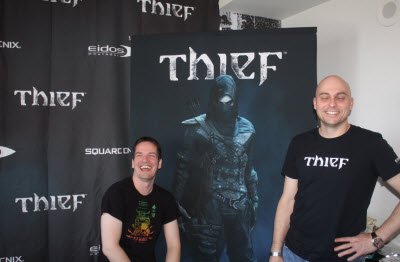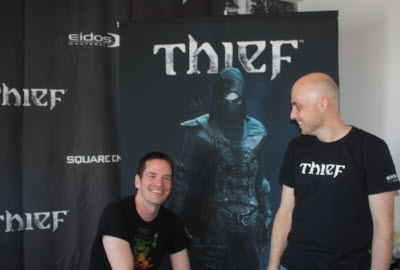Steven Gallagher, narrative director of Thief, gave a stirring performance when he recently described the plot of the new stealth adventure game. After all, he’s pretty passionate about the first new Thief title in a decade.
Eidos Montreal, a division of Japan’s Square Enix, is prepping the game for launch in February 2014 on a variety of platforms. We recently saw the latest build of the game, which, like Tom Clancy’s Splinter Cell: Blacklist, gives you the option of sneaking past guards and stealing goods or using your weapons in a vengeful way. Gallagher filled us in on the storyline and Stephane Roy, senior producers, described the gameplay. Here’s an edited transcript of our conversation.
GamesBeat: Do you have a Shakespearean background? There seemed to be a little of that in your presentation.
Steven Gallagher: No, I’m just kind of a creative guy. I used to be in animation. I’ve always been in acting of a kind. It helps in the storytelling. I like moving around.
GamesBeat: To start, remind us of the storyline for this game.
Gallagher: In a nutshell – it’s going to be a big nutshell – Garrett has a protégé, a young girl named Erin who he tries to teach to be like him, to be a master thief. She has a propensity for killing, which Garrett doesn’t like – his feeling is that a master thief shouldn’t kill without thought or good reason. This causes them to split under bad circumstances.
Some time goes by, and Basso — Garrett’s old friend and fence – brings them back together again, thinking it would be a good idea to pull off the biggest heist he’s ever come across, to steal from Baron Northcrest himself. Garrett decides to go ahead with the job, even though his head is telling him it might be a bad idea. Due to a decision Garrett makes that he thinks will solve a problem, things actually become much worse. There’s a bad accident, and Erin dies.
Garrett also falls in the accident and is knocked out. When he awakens and comes back to the city, everything seems a bit strange, and after he goes to see Basso it appears that he’s been away for a year. That’s when the game starts to unfold. The player opens up the plot of where Garrett has been and what’s happened in the city.
GamesBeat: If you could take me back to the approach for this game, what do you want to do differently? How did you start thinking about this one?
Gallagher: From my point of view, in terms of the universe and the environment, it’s still a Thief game. It has that Thief feel. Garrett is still that wry, dry character that we wanted to bring over. But for want of a better expression, we wanted to bring him to a contemporary audience. We have a much bigger cinematographic feel to the storytelling. You have a very privileged place inside Garrett’s head. It’s a first-person game. You are Garrett.
GamesBeat: Why did you want to start the game the way you did? What does that set you up to do, creatively?
Gallagher: From a story point of view, it’s because — I like to say I sit with Garrett a lot. I talk to Garrett in my own head. I asked him, ‘Okay, so you don’t like talking to people. You don’t socialize. You’re good at everything you do. So what’s your weakness?’ That’s when I realized that his weakness really is on the social side of things. That’s why we started the story from this protégé angle, where he has this more social element of the story he has to deal with.
GamesBeat: He can’t work with somebody else?
Gallagher: It just goes against his grain. He’s an independent spirit. To be trapped in this scenario — He’s always said, “I don’t work with anyone. I don’t need anyone. I don’t trust anyone.” But there was something about Erin. Maybe he recognized a bit of himself in this girl and realized that maybe she could be a thief like him as well. Maybe that’s why he couldn’t resist.
GamesBeat: Does that also set up interesting gameplay in a way that’s different from what’s happened in the past?
Gallagher: I’ll segue way to Stef on this, because he has more to say about the gameplay. What I will say about what the narrative does for gameplay is that it doesn’t try to penalize you. If you want to play aggressively, you’re allowed to be an aggressive thief. Obviously the narrative reminds you, though, that you’re a master thief, not necessarily a master killer. From a narrative point of view, I don’t want to get in the way of how players want to play the game. That was one of the biggest challenges to the design team, trying not to penalize players for the way that they play.
Stephane Roy: The name of the game is Thief. The story and the gameplay mechanics all revolve around that. Like Stephen said, you can be aggressive or be a perfect ghost, but you always have to keep in mind that it’s the way a thief would be, not a soldier. All the mechanics we have support that type of stealth gameplay. We don’t try to be everything, honestly. We don’t want to be an RPG or an action game, exactly. We’re this game, a Thief game. Thief created that type of gameplay, and we want to embrace it and continue in that direction. The mechanics and tools we have are created with this in mind. At the same time, though, we don’t just want to copy the past. We have our own flavor for it.




